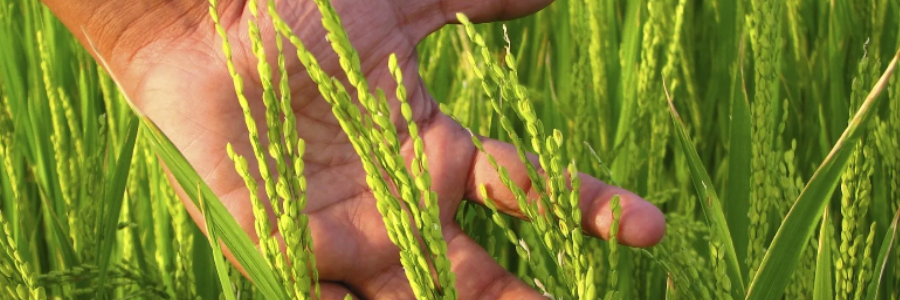step-by-step guide to the main activities that went into setting up our rice-growing initiative

Fixing the Irrigation System
To make the irrigation system effective it was necessary to excavate the channels, clearing away the debris. We then rebuilt the weir using reinforced concrete and special grade cement to cope with the water flow. Finally new gates were built and installed to enable the flow to be regulated. All of this was done for us by the County Irrigation Office of Kisumu.

Farmer Training
Before each stage, training was given to the farmers based on cutting edge agronomy and training practices. Training took place at the farm of one of the 30 lead farmers, who later delivered the training to the farmers in his/her group. These farmer field schools used hands-on teaching methods focused on what is going on in the land at the time, with information mainly shared through question and answer.

Land Preparation
Once there was sufficient water available from the repaired irrigation system the land could be prepared. This was achieved by flattening it where necessary and using rotivators attached to tractors, on hire from the Ahero Co-operative Society, in order to turn over the soil.

Seed Selection
Two varieties with good cooking qualities were chosen – IR2793 (Non-Aromatic) and Basmati (Aromatic) – both sourced from the National Irrigation Board research station in Ahero. By placing seeds in a bowl of water mixed with salt we ensured that most non-viable seeds were discarded (as non-viable seeds float). The viable seeds that sink are washed to remove salt and then soaked in water before being sowed.

Nursery Planting
The farmers were trained on the best techniques to sew the seeds provided in a well prepared nursery bed prior to planting them in their growing areas. This ensured that the right density of seed was planted – sufficient but with minimal wastage.

Transplanting
After 10-15 days in the nursery area it was time to transplant the seedlings into their growing area. Important here was training of the farmers in the use of ropes for alignment and correct spacing of the transplanted seedlings.

Applying Fertilizer
Two kinds of fertilizer were provided. NPK – a fertilizer composed principally of nitrogen, phosphorous and potassium to enrich the soil with key nutrients in which it is naturally deficient and SA a fertilizer which adds ammonium sulphate to the soil.

Protection from Pests
An organophosphate based non systemic insecticide was provided and also a systemic fungicide which has both protective and curative qualities. Field schools were run for the farmers in the application of the fertilizers and the pesticides.

Harvesting
Where necessary the farmers were helped with advances to enable them to pay workers to assist with the cutting and threshing activities.

Drying
This preparation to milling has been conducted either at the mill’s own drying floor or, for farmers further away from the mill, for their convenience, at a local school. The rice is tested using a moisture meter to ensure it has reached the necessary level of dryness (maximum 14% moisture content) which will enable the rice to be stored without deteriorating.

Milling
The milling, at Western Kenya Rice Mill, both removes the husks from the rice but as part of the process also grades the rice separating out the Grade 1 premium rice which is sold as Superior Kenya Rice from Grade 2 and broken rice which may be sold separately. This rice is bagged, with the other by-products – Chicken Feed, Rice Bran and Husks – providing an additional source of income.

Selling the Rice
The rice is being sold in bulk to institutions such as schools who need large quantities and will benefit from its highly nutritious qualities. Other commercial sales are in packs of 1kg, 2kg or 5kg attractive packaging. Profits from sales enable us to continue, and hopefully expand to benefit more farmers.
The project consists of six main components:
Irrigation
Refurbishment and maintenance of the weir at the Nyando river to ensure reliable water supply for the local rice schemes. This will ensure reliable and timely supply of water and enable farmers to grow two rice crops per year, dramatically increasing income from rice growing.
Farming inputs
Farmers received carefully selected rice seed varieties, fertilizers, and pesticides to achieve the maximum potential. Farmers will be supplied with planting fertilizer, top dressing fertilizer, fungicides, foliar feed and insecticides—to ensure a high yield. We expect that farmers will produce 30 kilos or more per acre—an increase of around 50%.
Finance
Purchasing good quality seeds and agri chemicals is expensive, so we have laid out for those inputs. We likewise have provided financial assistance for several other things, including hiring tractors for land preparation, milling and design and printing of bags. These costs will be recovered from the sale of the crops.
Information & Training
Farmers receive training and support throughout the process in best planting techniques as well as the correct use of the fertilizers and pesticides to ensure high results are achieved.
Milling & storage
We are arranging the processing of the rice to increase its value and attract higher prices. We have therefore arranged for the rice to be milled by the National Irrigation Board (NIB) where it will be kept in storage so that it can be sold at a better price.
Marketing
We are supporting the farmers in all aspects of marketing, from securing accreditation for the rice to designing attractive packaging to finding buyers.
